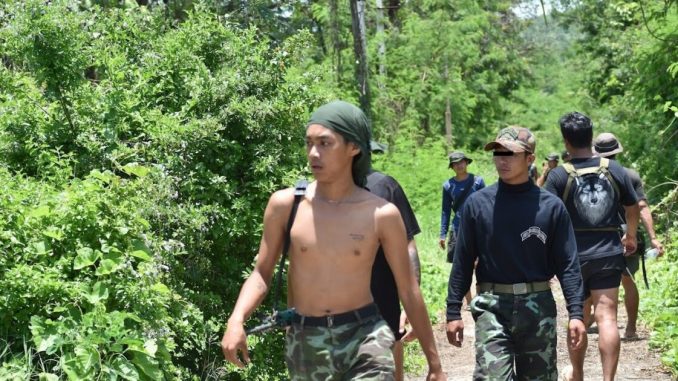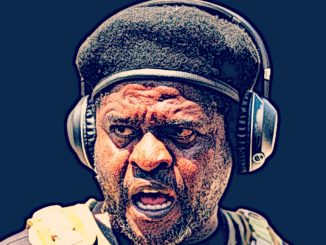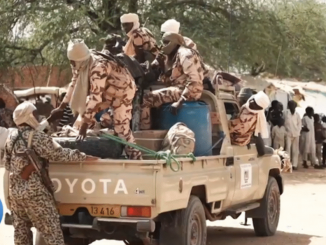
Inside former SAC base, Pasaung Photo by Antonio Graceffo
Published October 5, 2025
China’s growing influence in Burma (Myanmar) has turned the tide of the ongoing conflict. What began as a popular resistance against the junta’s military takeover is now collapsing under Beijing’s technological and logistical support for the regime.
Chinese drones, ammunition, and surveillance systems have given the junta air superiority and the ability to track and crush resistance movements. Reports show villages reduced to rubble, civilian deaths mounting, and entire communities fleeing toward Thailand and India.
On the ground, the junta claims “stability,” but the reality is a nation under siege — politically, militarily, and economically. Myanmar’s supposed 2025 elections are nothing more than a carefully staged illusion of democracy, with China and Russia poised to endorse the outcome.
By weakening Burma’s freedom movement, Beijing secures not only trade routes for its Belt and Road projects but also a foothold of control deep within Southeast Asia. The silence of international organizations and neighboring countries gives China free rein to expand its reach — while the Burmese people lose both freedom and hope.
 Inside former SAC base, Pasaung Photo by Antonio Graceffo
Inside former SAC base, Pasaung Photo by Antonio Graceffo
 Free Burma Rangers (FBR) medics, doctors and nurses work to save the lives of wounded soldiers. Photo by Antonio Graceffo
Free Burma Rangers (FBR) medics, doctors and nurses work to save the lives of wounded soldiers. Photo by Antonio Graceffo
 Public / Political Reactions
Public / Political Reactions
Key Actors & Their Reactions
1. Myanmar’s Junta / State Authorities
-
The military regime has attempted to frame its planned elections (December 2025 / January 2026) as legitimate and a return to constitutional order. However, critics widely denounce them as a “sham” election that consolidates military power rather than restoring democracy.
-
The junta announced partial lifting of the state of emergency in some areas (July 2025) to enable elections, though it simultaneously imposed martial law in other regions due to “security concerns.”
-
Within the military-government circles, there seems to be unease or suspicion towards China’s increasing involvement. Some in the junta reportedly view China’s support as overstepping, and see mutual distrust underlying the alliance.
-
State media and junta spokespeople often label resistance groups as “terrorists” or threats to national unity, and attempt to delegitimize calls for federal democracy.
2. Resistance Forces, Ethnic Armed Organizations, & Pro-Democracy Factions
-
The resistance and ethnic armed organizations (EAOs) continue to depict China’s support for the junta as a betrayal of Myanmar’s sovereignty, and see it as a major obstacle to achieving a federal democratic system.
-
The National Unity Government (NUG) and allied groups have called for international pressure, arms embargoes, and accountability measures (e.g. sanctions, ICC referrals) against the junta.
-
In specific incidents (e.g. the Pinlaung massacre), opposition voices and civil society highlighted that the regime’s narrative was false, demanded independent investigations, and framed attacks as terror campaigns or sectarian provocations.
-
Many EAOs who had been somewhat neutral or cautious have been pressured (or coerced) by China to limit or cease supplying arms or cooperation with resistance groups — a dynamic some resistance groups publicly criticize.
3. Civil Society, Human Rights Groups & International Organizations
-
Human rights organizations, UN offices, and civil society networks have repeatedly condemned the junta’s repression, arbitrary detentions, torture, attacks on civilians, and the breakdown of the rule of law.
-
In 2025, the UN human rights office (OHCHR) published reports detailing the rising number of civilian casualties, the use of torture and extrajudicial executions, and cautioned about the regime’s crackdown on dissent.
-
Some civil groups have lobbied to remove the junta-controlled Myanmar National Human Rights Commission from regional human rights institution networks (arguing its lack of legitimacy).
-
Internationally, governments and external actors vary in response. Many Western or democratic states criticize the junta’s elections, call for respect for human rights, and maintain sanctions. However, credible, forceful intervention remains limited by geopolitical constraints.
-
Analysts and commentators warn that China’s support may be strategically short sighted: while it might stabilize the junta in the near term, it weakens China’s image among Myanmar’s population and complicates long-term stability.
Observations & Trends in the Reactions
| Trend | Description |
|---|---|
| Polarization & Messaging Battles | Both junta and opposition groups actively vie to frame legitimacy, sovereignty, and justice in their terms. |
| Skepticism toward China | Even among regime-aligned elements, China’s deeper involvement is sometimes seen as intrusive or self-serving. |
| Legal & International Leverage | Resistance forces, civil society, and NGOs increasingly use international legal forums, sanctions, and human rights mechanisms to press their case. |
| Humanitarian Emphasis | Many reactions emphasize the plight of civilians, displacement, food insecurity, and war crimes to draw broader sympathy and pressure. |
| Regional & Diplomatic Restraint | Some regional actors and powers prefer stability over aggressive intervention, leading to muted or cautious public stances. |
 Resulting Effects
Resulting Effects
⚔️ 1. Battlefield Shifts and Resistance Losses
-
Supply Chain Collapse:
The Gateway Pundit article notes that Chinese pressure on ethnic militias (like the United Wa State Army) to halt weapons sales has crippled resistance logistics. Fighters in Karenni and Shan States are now running low on ammo and parts for drones. -
Loss of Air Defense:
The junta’s Chinese-supplied aircraft, drones, and surveillance tech have tipped the battlefield balance. Without anti-air capabilities, resistance groups are forced into guerrilla tactics again, losing their earlier momentum in open-terrain battles. -
Intensified Bombings:
Junta forces have bombed IDP (Internally Displaced Person) camps and medical outposts. Humanitarian organizations estimate thousands more displaced in Karenni and Sagaing States since August 2025. Civilian casualties have risen sharply as air power dominates.
🪖 2. Political Leverage for the Junta
-
Pre-Election Territory Push:
The regime’s air dominance and Chinese assistance have enabled recapture of several townships before the planned 2025–2026 elections. Analysts say the junta wants to hold “controlled elections” mainly in secured zones to fabricate legitimacy. -
Propaganda Surge:
State media now publicizes “victories over terrorists,” showing footage of Chinese-made drones destroying rebel posts. These narratives aim to project control and stability, even as fighting continues elsewhere. -
China’s Strategic Gains:
Beijing has secured new infrastructure and border trade assurances from the junta in exchange for support — including easier access for Chinese goods and security for Belt and Road projects near Muse and Mandalay.
💣 3. Humanitarian and Social Fallout
-
Rising Civilian Death Toll:
UN and NGO field teams report hundreds of new casualties per month, especially from drone strikes and cluster munitions. Entire villages have been evacuated near Loikaw and Pekon due to daily bombings. -
Justice System Breakdown:
As highlighted in the “4 October 2025” Nway Myanmar Channel video, the country’s legal system is collapsing — courts no longer function in resistance-held areas, and junta-controlled courts issue death sentences for dissenters without trial. -
Education & Economy Collapse:
Schools in rural states have shut down for nearly two years; inflation and sanctions have wrecked urban economies. Locals rely on informal trade networks, many now influenced or taxed by Chinese and junta-linked businesses.
🌏 4. Regional and International Consequences
-
ASEAN Fracture:
ASEAN’s “non-interference” policy remains, but internal criticism grows. Thailand and Malaysia are quietly coordinating refugee management as border crossings surge. -
Western Response:
The U.S. and EU maintain sanctions but have not intervened militarily. Sanctions on Chinese companies involved in junta arms sales are being considered but not yet implemented as of October 2025. -
Geopolitical Messaging:
China uses Myanmar to showcase its regional reach — signaling that it can stabilize its southern flank and counter Western pressure, even at the cost of reputational backlash.
📉 5. Psychological and Moral Impact
-
Resistance Fatigue:
Fighters face burnout and disillusionment, lacking ammunition, foreign support, or media visibility. Many communities now prioritize survival over active rebellion. -
Civilian Distrust Toward China:
Public sentiment in Myanmar — even among some ethnic Chinese communities — has turned against Beijing, accusing it of “choosing dictatorship over peace.” -
Moral Narrative Shift:
The junta portrays itself as the defender of national sovereignty against Western “meddling,” while the resistance frames the war as a spiritual and generational struggle for freedom. The resulting polarization is deeper than ever.
 Future Outlook
Future Outlook
🔮 1. Short-Term (Late 2025 – Mid 2026)
Military Landscape
-
Junta Consolidation in Core Regions
With Chinese backing—drones, fuel, surveillance tech—the regime is expected to hold most urban centers and key trade routes (Mandalay, Naypyidaw, southern Shan). -
Resistance Regroups in Periphery
The People’s Defense Force (PDF) and ethnic armies will likely retreat to border strongholds (Chin, Kachin, Karenni). Expect continued guerrilla ambushes, sabotage of convoys, and attacks on infrastructure. -
Drone & Air War Expansion
China’s drones will keep giving the junta an edge. However, homemade counter-drone systems and smuggled MANPADS (portable anti-air missiles) may slowly appear, leveling the field in limited areas.
Humanitarian Pressure
-
Mass Displacement Continues
Refugee crossings to Thailand and India could exceed 3 million by mid-2026 if bombing continues. -
Health and Food Crises
Malnutrition and epidemic risk are rising as aid corridors shrink. China may use “humanitarian assistance” as soft-power leverage to justify deeper involvement.
🗳️ 2. Political Trajectory
Controlled Elections
-
The junta plans elections for late 2025 / early 2026, but they’ll likely be confined to secured zones under military control.
-
Voter turnout will be low, and resistance groups will reject the process entirely, branding it a puppet vote.
-
China and Russia will probably recognize the outcome; Western democracies will not.
China’s Balancing Act
-
Economic Entrenchment: Expect China to expand Belt-and-Road projects (rail, pipelines) and secure long-term mining leases.
-
Diplomatic Tightrope: Beijing will continue insisting on “non-interference” while effectively propping up the junta, risking backlash among Myanmar citizens.
-
Regional Mediation Role: China may present itself as a “peacemaker” to ASEAN, brokering limited ceasefires that protect its investments more than civilians.
🌏 3. Regional and Global Implications
| Region / Actor | Probable Direction |
|---|---|
| ASEAN | Fractured response—Thailand and Malaysia push humanitarian corridors; Singapore and Indonesia avoid confrontation with China. |
| India | Fortifies its northeast border, wary of refugees and Chinese influence near Mizoram. |
| West / EU / US | Continue sanctions and funding for humanitarian relief; no direct military aid expected. |
| Russia | Maintains arms trade, seeing Myanmar as another foothold for defense exports post-Ukraine isolation. |
💰 4. Economic and Social Future
-
Collapse of Civilian Economy
The kyat’s value is unstable; urban unemployment surpasses 30%. Local markets rely on barter and black-market fuel. -
Rise of War Economies
Border trade—especially jade, timber, and narcotics—will sustain both junta and resistance pockets. -
Generational Migration
More young Burmese are fleeing abroad for work; “brain drain” threatens long-term recovery.
🕊️ 5. Possible Turning Points
-
If China Overextends – Beijing risks backlash if civilian casualties are directly tied to its drones or advisors. Domestic anger could turn Myanmar’s future generations staunchly anti-China.
-
If the Resistance Gains External Support – Covert aid (possibly via Taiwan or sympathetic NGOs) could tilt small battlefronts, prolonging the war.
-
If ASEAN Finally Intervenes – A joint humanitarian or monitoring mission, even symbolic, could constrain the junta’s actions and shift regional norms.
-
If the Economy Implodes – Unpaid soldiers and resource shortages could cause cracks within the military ranks, sparking mutiny or internal power struggles.
 Bottom Line:
Bottom Line:
China’s growing hand in Burma’s (Myanmar’s) war is not about peace — it’s about power and control. Beijing’s weapons, drones, and political leverage are keeping a brutal junta alive, crushing a people who only want freedom and self-determination.
Once again, the Chinese Communist Party shows the world what it really stands for: propping up tyranny to secure its borders and business interests. The so-called “elections” the junta plans are nothing more than a smokescreen for dictatorship, rubber-stamped by China and Russia, while ordinary Burmese pay the price in blood.
The West’s silence and ASEAN’s caution have allowed China to fill the vacuum, turning Myanmar into yet another testing ground for Chinese influence and authoritarian expansion. This isn’t just about one country’s civil war — it’s a warning to the entire region.
If democracies continue to look the other way, China’s shadow will keep spreading — from the mountains of Burma to every frontier where freedom still flickers.
SOURCES: THE GATEWAY PUNDIT – China Weakens Burma Resistance Amid Intensified Fighting
THE IRRAWADDY – China’s Support of Myanmar Junta Will Prove Short-Sighted





Be the first to comment